
The John Ward House is a National Historic Landmark at 132 Essex Street in Salem, Massachusetts, United States. With an early construction history between 1684 and 1723, it is an excellent example of First Period architecture, and as the subject of an early 20th-century restoration by antiquarian George Francis Dow, it is an important example of the restoration techniques. Now owned by the Peabody Essex Museum, it is also one of the first colonial-era houses in the United States to be opened as a museum. It was designated a National Historic Landmark in 1968.

The Abbot-Stinson House is a historic house in Andover, Massachusetts. The house is estimated to have been built in the early 1720s, in the transitional period between First Period and Georgian styles of construction. It was originally one room deep with a central chimney, but was extended by additions to the rear in the 20th century. The house was listed on the National Register of Historic Places in 1990.

The Austin Brown House is a historic late First Period house in Hamilton, Massachusetts. The oldest part of the house is the central core, a 2+1⁄2-story structure with a central chimney, was built c. 1725. A leanto section was added to the rear in the 18th century, and an ell was added to the left in the 19th century. At some point the leanto section was raised to a full two stories. In 1907, the house underwent significant restoration and enlargement, adding the right-side wing and replacing the roof with a higher pitch one with three gable dormers. The exterior was stuccoed at this time. Despite these changes, the First Period core of the house is largely preserved.

The Carlton-Frie-Tucker House is a historic First Period house in North Andover, Massachusetts. It is a rare example of a period building that was moved and added onto another which had been damaged by fire. The oldest portion of the house, its east side and center chimney, were probably built c. 1709 by Ebenezer Frie. The west side of the house is a second structure that was attached to the first in the 1760s, with some documentary and physical evidence that this was due to a fire destroying the original west side. A leanto section was added to the rear of the house in the 20th century, as was a wing on the northwest corner, connecting the house to its barn.
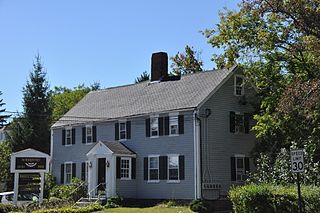
The Benjamin Coker House is a historic First Period house in Newburyport, Massachusetts. The oldest portion of the house, the central chimney and the rooms to its left, were built c. 1700 on a site at the corner of High and Federal Streets. The building was widened in the mid 18th century, adding the rooms to the right. The building was moved to its present location in 1856, and enlarged with a two-story addition on the rear. It underwent a major rehabilitation in 1989, but retains some mid 18th century decorative details.

Samuel FryeHouse is a historic First Period house in North Andover, Massachusetts. Tradition places its construction between 1711, when a previous house on the site burned down, and 1719, when Frye gave the property, with house, to his son. The house was in the Frye family until 1880. It is a 2+1⁄2-story wood-frame house, one room deep and five bays wide, with a rear leanto section that was added in the 19th century. The house is notable for its retention of a tradition two room form despite the removal of its central chimney during Federal period renovations.
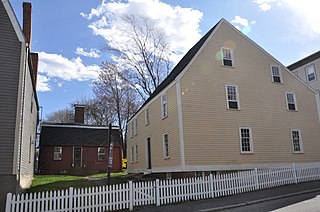
The Gedney and Cox Houses are historic houses at 21 High Street in Salem, Massachusetts. The earliest part of the Gedney House was built c. 1665, and the houses were added to the National Register of Historic Places in 1974. They are owned by Historic New England, which offers limited tours.

The George Giddings House and Barn is a historic First Period farm in Essex, Massachusetts. Both the house and the barn are estimated to have been built in the 1690s, and contain construction details unique in Essex County First Period buildings. The house was originally built as a single two story cell structure with a large chimney on one side, which was then widened with the addition of a second cell on the other side of the chimney. In the 19th century a number of alterations were made: the central chimney was removed, the entry of the house was reoriented from south to north by the addition of a new central door on the north face, and two new chimneys were added along the north elevation. The house has modern additions to the rear (south) side. The barn is of a similar vintage to the house, although it started with only five windows, and was extended at some point by the addition to the east of a sixth bay. It is one of a very few surviving First Period barns.

The Hart House is a historic First Period house in Lynnfield, Massachusetts. The two story, three bay wood-frame house was built in stages. The oldest portion is the front of the house, consisting of two stories of rooms on either side of a central chimney. It was probably built by John Hiram Perkins, the owner of the property from 1695 to 1719. Not long afterward, a leanto section was added to the rear, giving the house its saltbox appearance. It was acquired by John Hart in 1838, and it remained in his family until 1945. Even though the house underwent a major rehabilitation in 1968, its First Period construction is still evident.
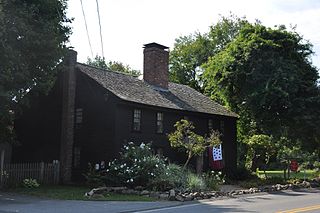
The William Livermore House is a historic First Period house in Beverly, Massachusetts. It is a 2.5-story five-bay colonial wood-frame house that was built in stages. The oldest part of the house, the right front, was built c. 1700, along with the chimney. The left side was added early in the Second Period, and a major addition was made to the rear, adding another row of rooms and a new roof. As a result, the chimney, which normally protrudes through the ridge of the roof in First Period houses, instead protrudes through the front of the roof.
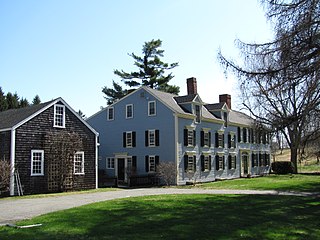
The Larch Farm, also known as the Goldsmith-Pickering House, is a historic First Period farmhouse in Wenham, Massachusetts. The house is a large colonial 2+1⁄2-story wood-frame house, eight bays wide. The northern half of the house is three bays deep, and the southern half is two deep. Its complicated construction history begins in 1700, when Zaccheus Goldsmith was given permission to take timber for the purpose of building a house 40 feet (12 m) wide and 20 feet (6.1 m) deep. This structure was two stories high, with a leanto section in the rear and a chimney on its right. An addition during the Georgian period removed that chimney and doubled the size of the house, and moved the front door to the north side. A wing was added on the south during the 1780s, and the exterior was remodeled later to give the house a Federal style appearance. The interior of the house includes surviving decorative features from all three periods of construction.

The Stanley Lake House is a historic First Period house in Topsfield, Massachusetts. It is a 2+1⁄2-story wood-frame house that was built in stages by Mathew Stanley or his heirs between c. 1675 and 1693 and subsequently enlarged by the Lake family. It illustrates a host of building practices over the 17th and 18th centuries. The first Matthew Stanley house was said by Dow to be located northwest of this building. The first portion of this building is the section from the chimney westward. An easterly room was added after and a further addition to the east by the Lakes c. 1750. Matthew Stanley's heirs having removed to the Attleborough Falls area, sold the 70 acre farm property 1710- 1718 to Eleazer Lake. The property also includes a rare First Period barn. It was listed on the National Register of Historic Places in 1990. In 2005 it was named a contributing property to the River Road-Cross Street Historic District.

The house at 922 Dale Street is a historic First Period house in North Andover, Massachusetts. It is a 2.5-story wood-frame house, five bays wide, with a small side porch and a rear single story addition. The oldest part of the house is the right rear portion, which is estimated to have been built in the first quarter of the 18th century, along with a central chimney. Sometime between 1740 and 1780 rooms were added to its left. A major renovation during the Federal period removed the central chimney, and added rooms in front of the earlier ones, giving the main block of the house its rectangular shape. The interior has some well preserved Federal period details.

The George Hopkinson House is a historic colonial First Period house in Groveland, Massachusetts. Built c. 1716, it is a rare surviving single cell house from the period. Most First Period houses were built in their first stage as a chimney section and a two-story section to one side, with one room on each floor, and were later extended with additional rooms on the other side of the chimney, giving colonial rooms their characteristic five bay appearance. Because this one was never extended in this way, it exhibits a three bay front, with a door in the right-side bay, in front of the chimney. A rear leanto section was added later in the 18th century, and the side ell was added in the 19th century. The house is also a rare regional instance of plank frame construction.
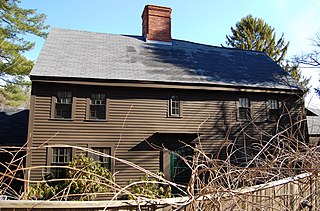
The Newman–Fiske–Dodge House is a historic First Period house in Wenham, Massachusetts. The house contains a rare instance of preserved 17th century decoration. Like many First Period houses, it was built in stages. The first part, the now-central chimney and right-side two stories, was built c. 1658, with the left-side rooms being added c. 1695–96. The fireplace in the right-side room contains original detailing that was covered over by paneling sometime in the 18th century, and the trim on the staircase to the second floor was probably added at the time of the addition.
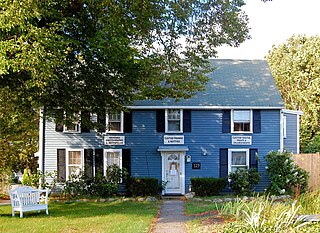
The Whittemore House is a First Period house in Gloucester, Massachusetts, built around 1700, based on an analysis of its framing and construction methods. It is a two-story wood-frame building with a two-story shed-style addition on the rear, and a single story addition on the right side. When first built, it consisted of two rooms with a chimney on the right; two more rooms were added in the First Period to the right of the chimney, nearly centering it in the house. The original chimney has since been removed.
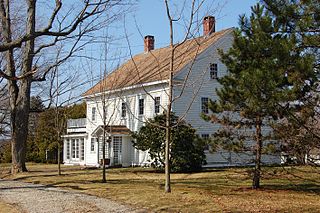
The White-Preston House is a historic First Period house in Danvers, Massachusetts. It is a 2+1⁄2-story wood-frame structure, five bays wide, with a side-gable roof, twin interior chimneys, and clapboard siding. Its main entrance is sheltered by a gable-roofed portico. The oldest portion of the house, its front right, dates to about 1722, with the front rooms on the left added soon afterward. In the 19th century the rear of the house was either rebuilt or enlarged to be a full two stories in height, and the house was given a modest Greek Revival stylistic treatment.

The Deacon Edward Putnam Jr. House is a historic First Period house in Middleton, Massachusetts, United States. The oldest portion of the house, its right (east) side and the central chimney, were built c. 1705, probably by Deacon Edward Putnam Sr. By 1718, Edward Jr. occupied the house with his family, by which time it had been expanded with rooms to the west. The house facade had, until renovations in the 1960s, an unusual three bay configuration, with two windows on the west side of the chimney and one to its right. The renovations in the 1960s added a lean-to section to the rear of the house, beyond which a single story ell connects the house to a series of barns.

The Col. John Osgood House is a historic late First Period house in North Andover, Massachusetts. The original part of the house, its left side, was built c. 1720. A second, similar building was then attached to the right side of the chimney at a later date, demonstrating an unusual method of joining the two structures. The house was listed on the National Register of Historic Places in 1990.
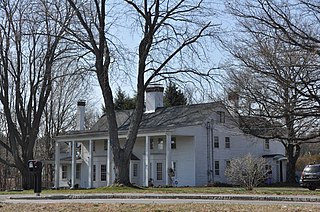
The Sawyer House is a historic First Period house in Boxford, Massachusetts. It is a 2+1⁄2-story central-chimney house with an attached rear two-story wing. A two-story full-width portico supported by seven turned columns shelters the front of the house. Like many First Period houses, this one was built in stages, and exhibits a variety of architectural styles despite its early origins. The first portion to be built was the center chimney and the two-story section to its right, in c. 1700. Later in the First Period the rooms to the left of the chimney were added. The rear wing was added in the 19th century, as was the front portico. There two further additions in the 20th century, including a sun room at the rear where the 19th-century addition meets the main house, and single-story shed-roofed addition on the west gable end, running the full depth of the house.























